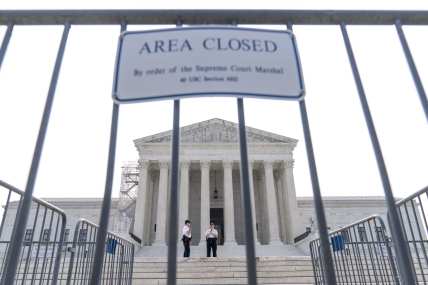WATCH: Affirmative action ruling is bad news for everyone
The Supreme Court ruled against affirmative action in college admissions
On Thursday, the U.S. Supreme Court ruled to end affirmative action from the college admissions process. As previously reported by theGrio, the ruling came after the court heard hours-long arguments last fall both in favor and against whether private and public collegiate institutions should consider race during the admissions process.
The policy was implemented in 1961 by President John F. Kennedy. According to American Association for Access, Equity and Diversity, Kennedy’s Executive Order (E.O.) 10925 used the policy for the first time by instructing federal contractors to take “affirmative action to ensure that applicants are treated equally without regard to race, color, religion, sex, or national origin,” established the Committee on Equal Employment Opportunity.
Host Natasha Alford breaks down how removing the policy can be bad for everyone.
The following is a transcript of that conversation
Natasha Alford: What’s mind blowing about these organized attacks on affirmative action, is that affirmative action started out to help people not face discrimination at work. In 1961, President John F Kennedy called for using affirmative action to, quote, “ensure that applicants are employed and employees are treated during employment without regard to their race, creed, color or national origin.”
Alford: It didn’t automatically mean getting a job just because of your race to the detriment of others. And it also was meant to ensure that you weren’t facing hardship just because of your race. Now, thanks to activists like Dr. King and Whitney M. Young, Jr, affirmative action policies went from being in the workplace to expanding into education. And in 1967, gender was added to the list of protected characteristics. So women of all races could also benefit from affirmative action.
Alford: The change actually increased the number of women in manager roles, and it opened up industries like medicine and architecture, and it increased the number of women earning bachelors and advanced degrees. Now, despite women and white women in particular, overwhelmingly benefiting from affirmative action, multiple polls show that the majority of white women actually oppose the policy. Perhaps these women and America in general have a problem with seeing the gap between who we say we are and who we actually are. [00:02:57][34.8]
Alford: For example, we we say we have schools and employers that are open to all, and we believe in equal opportunity. But when you remove actual affirmative action policies, research shows that representation drops significantly even in today’s supposedly progressive society. It’s funny that just hoping people do the right thing doesn’t actually work. That’s why policy matters.
Alford: What’s been consistent and all of these attacks on affirmative action is that only focusing on Black people as the beneficiaries of these policies is a very strategic move. It ignores just how many other groups have benefited from affirmative action, and it plays into the stereotypes of Black people getting advantages that they don’t really deserve. That really gets the people going. But in trying to make sure that black folks don’t get an unfair leg up, other people are most definitely going to be hurt when you take away affirmative action.
Alford:It means losing educational opportunities, not being considered for jobs, and everyone overall just missing the benefits of diversity and the brilliance of diverse minds all in one place.
TheGrio is FREE on your TV via Apple TV, Amazon Fire, Roku, and Android TV. Please download theGrio mobile apps today!

